|
|
The Dorchester Belt
Introduction.
Shown opposite are the finds discovered at Dorchester-on-Thames
by workmen in 1874. Sadly, it is believed they also threw some
ironwork into the River Thames - possibly the remains of the original
owner’s sword! Regardless, the surviving belt parts provide a
perfect opportunity to recreate a known 4th/5th century AD artefact,
as shown opposite. Why recreate a specific belt/ grave finds?
The advantage of recreating a specific grave find is that it is
difficult to go wrong as regards authenticity. You know that these
items were worn by one man, in one place, in a defined time period.
It also allows you to build a picture of the person who wore them
by looking at what the area was like, what was happening and,
building on the known facts to try and tell his story. It’s the
story of one of the very last men who would see themselves as
part of the Roman Army in Britain. This is my attempt to recreate
his story.
What was found? Firstly, was the grave of a
man over six feet tall (described in the original account of the
discovery as being “of enormous size”) - we’ll call
him Magnus - buried in a coffin at a depth of four feet, oriented
SSE-NNW, with knees bent. Within this grave were found the fittings
of a late Roman military belt, a round disc of antler or bone, with
circle and dot markings, and several pieces of iron, one of which
being a knife 5 1/18 inches long. The belt buckle had been damaged
and repaired in antiquity and the belt fittings show signs of heavy
use. In addition, the grave of a woman was also unearthed containing
a classic late Roman cruciform brooch, together with brooches and
belt fittings indicating a north German origin - possibly Frisia.
This has been assumed to be his wife.
Where were the graves found? The graves
were found on the eastern side of the old British oppidum guarding
the bend in the River Thames, which also served to protect its eastern
flank, and with a Celtic hill fort opposite. The location provided
perfect observation and was strategically well positioned with the
ramparts and river forming a continuous defence. These still survive
- in deteriorating condition - as the Dyke Hills south of modern
Dorchester. The walled Roman town and fort of Dorchester was sited
to the North. The old oppidum ramparts may well have deteriorated
by the Roman’s arrival, but it would have made sense for them
to be re-fortified in the later Roman period - an action paralleled
in other towns. Another cemetery was in use before and after this
time to the East of Dorchester, but as at Caistor St Edmunds, there
seems to have been a separate cemetery for the Romano-Britons and
their Germanic defenders. |
By Caballo(Paul Brown)
|
|
Paul Browne’s reconstruction of the Dorchester-on-Thames
belt. |
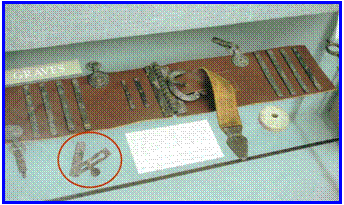 al
The actual finds from Dorchester-on-Thames, dating to the 4th/5th
century AD, on museum display. al
The actual finds from Dorchester-on-Thames, dating to the 4th/5th
century AD, on museum display. |

Dorchester Oppidum, viewed from the North.
The arrow indicates the graves. (By kind permission of Dominic
Andrews)
|
|
Putting it all together - the detective work. So how did the
artefacts found fit together to form a belt - and what was the
mysterious circular object with dots and circles? Usefully, similar
finds in Batavia - one with the leather still on - revealed the
basic belt construction. Yet, as the first attempted reconstruction
drawing made by very eminent authors in 1952 demonstrates (opposite),
we may still get our reconstructed interpretation very, very wrong!
Another important question centres on what may have been missing
from the burial? A Batavian burial in Donderberg (bottom right)
contained a very similar belt buried with a spear, a knife, a
pointed shield boss (with a curved flange indicating a curved
shield) and a “francisca” throwing axe. Other finds
with a similar belt have been found in Milton, Kent; Tournai,
Furfooz near Naumur, and Vieuxville (all Belgium); Vermand and
Monceau-Le-Neuf, Aisne in France; and Mainz-Kastheim, Germany.
Apart from the belt fittings, each grave contained items such
as a sword, throwing axe, spear, knife, arrows, cross bow brooch,
bone comb, scales, a silver spoon, whetstone, bronze neck ring,
tweezers, bead toggle, coins, and pottery, bronze, and glass vessels.
All of these artefacts give us some idea of the sort of items
that could be used to recreate Magnus’ appearance.
Magnus’ grave was missing his cruciform
brooch - his “badge of office” - in fact, no brooches
at all were found. But in his “wife’s” grave, there
it is. Let’s conjecture, that just as the wife of an RAF pilot
may wear a brooch in the shape of her husband’s wings, Magnus’
wife may have kept the brooch as a reminder of him and his status.
Some items remain puzzling. The item marked 13
(see picture opposite) was clearly used to attach securely something
that needed to be detached for use. One writer suggests a whistle.
It could be a pouch, or a firesteel. Or something else. This remains
to be made. Also, are artefacts 9 and 10 damaged attachment points?
And what is number 2?
The off-white bone/ antler/ ivory circlet with
dot and circle markings was initially thought to be a spindle
whorl, but contemporary notes place it in Magnus’ grave as
a toggle or early scabbard amulet. It has been re-created as a
scabbard amulet, similar in shape to other examples from continental
Europe. There is talk in some of the sagas and stories of these
amulets being used to prevent sword wounds getting infected, or
as a “peace binding” to prevent sudden drawing of the
sword.
What else do the artefacts tell us about the
person who wore the belt? Dragon head buckles and related belt
fittings are found either in Continental Europe or in south-east/
eastern England. Some of these may represent the presence of foreign
troops in the east coast Saxon Shore defences.
Indeed, the find locations of dragon buckles
have strong parallels with the earliest Anglo-Saxon settlements.
Moreover, it has been suggested that such buckles are clearly imports
rather than locally manufactured. The implication is that the corpse
(‘Magnus’) either originated from or had strong links
to the continent, and may have been connected to the Roman army
before the Anglo-Saxon migration.
The belt stiffeners are seen as late 4th or 5th
century AD - again helping date the individual. The strap end
is of a 5th century type often associated with fixed plate dragon
buckles. And the brooches found in the woman’s grave originate
from Germany - again perhaps Frisia.
Recreating the Dorchester Belt. In recreating
the belt I used the excellent reproductions made in bronze by
Nodge Nolan for Adrian Wink (Peronis) at ‘Armamentaria’
. I also benefitted from and am extremely thankful for Adrian’s
advice and help throughout. Cheaper versions of the stiffeners
are available from Raymond’s Quiet Press, but they have neither
the weight nor the accuracy. Nodge’s bronze work simply feels
right…The stiffeners were riveted to vegetable tanned leather
95mm wide (it’s a very wide belt!). The leather was dyed
black by soaking it in vinegar containing rusty nails - the chemical
reaction with the open air and daylight produces the black colour.
For best results, leave the leather in the vinegar and rust solution
for a couple of days. Given the smell, and to preserve the best
marital relations, do this by the shed at the end of the garden,
well away from the house…
The Ashmolean Museum, Oxford, have recreated the belt with a quasi
Sam Browne baldric as shown in the illustration (opposite) taken
from Osprey’s ‘Germanic Warrior’ by Simon MacDowell.
Given a separate baldric to take the weight of the sword, I have
gone for the rosettes and suspension rings as being a series of
holding points - rather like a modern police utility belt. I’ve
also avoided the unsheathed knife depicted in Angus McBride’s
Osprey illustration, which has always struck me as a little too
close for comfort…
The Sword Amulet. I’ve seen several alternative
descriptions of the sword amulet - variously saying that it is
horn, ivory or bone. I decided on an ivory reconstruction - other
sword beads/amulets tend to be made of rare or precious substances
such as amber. As real ivory is (of course) not legally available,
I used an alternative material from Ivory Alternatives:
Ivoryalternative.
The ‘ivory’ comes in a cylinder, which I sawed to
shape and then sanded off the shiny exterior. The dot and circle
design were then made using awls from Daegrad (sold via eBay).
I attached the disc to the scabbard of the spatha using braided
sinew, with horn toggles (in the unlikely event of any peace binding)
made from an antler tine found in my ‘Bits Box’. For
info, the sword hilt shown below left was made by David Hare of
the Ermine Street Guard. For comparison, shown below right is
a late 5th century Germanic sword found at Blucina recreated by
Patrick Barta.

|
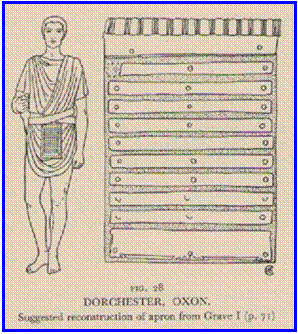 |
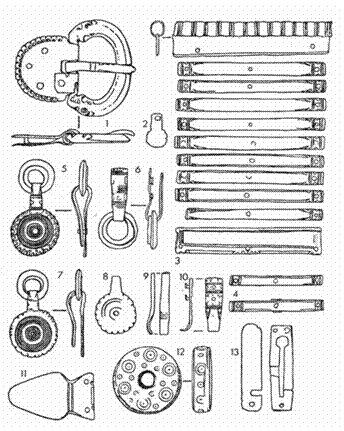
The Dorchester Grave Artefacts
(From Hawkes, after Oxoniensa)
|

Contents of the Donderberg grave
(after Nicolay, 'Armed Batavians')
|

|
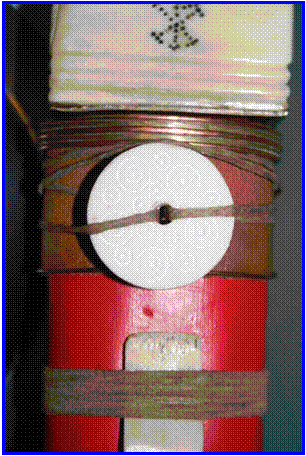 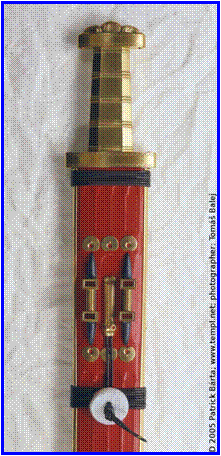 |
|
|
Magnus and Late
Roman Dorchester.
Our recreated hero, ‘Magnus’, was of Germanic origin -
possibly a Batavian - based on the similarities with almost identical
belt finds. It is reasonably safe to assume that Magnus had served
in the Roman army before settling in Dorchester. The recovered belt
from his grave is dateable to the 4th century AD, but was obviously
well worn on burial and revealed signs of repair. The woman discovered
in a nearby grave is assumed to share Magnus’ North German
origin, possibly Frisia, as evidenced by the artefacts buried with
her. It is possible to speculate that, perhaps having married a
Germanic woman, Magnus chose to stay in Britannia on discharge to
become part of, and possibly organise, a local Dorchester-based
militia. He was clearly not buried in the Roman cemetery, but in
the ramparts of the old oppidum. The original excavation notes from
1874 mention other burials, so there may well be more to find. In
fact, the 1952 article by Kirk and Leeds recommends ‘a mine
detector run over the tops of the banks might well reveal more burials’.
While modern archaeologists, and English Heritage, might disagree
with this tactic, why was Magnus buried in the oppidum’s rampart?
Perhaps he was not a Christian or, at least, an
“acceptable” Christian - the ‘Arian heresy’
was strong in the Germanic peoples, for example. Yet, despite
the strong state sponsorship of Christianity at this period, there
were no Christian symbols in Magnus’ burial. More likely
is that, as in other towns, it was simply a case of racial segregation
in death between Romans and Germans. Such segregation may reflect
a general distaste by the Romans towards the ‘barbarian’
Germans. Sidonius Appolinaris in 5th century AD Gaul, for example,
wrote that the invading Germanic barbarians were ‘quarrelsome,
drunken and disgusting creatures’. He even described one
as a seven foot tall, long-haired eater of onions, who smeared
his locks with rancid butter.
What was 4th/ 5th century Dorchester like?
Firstly, Dorchester was a small walled town, as evidenced by the
size of its cemetery - some have estimated its population to be
only about 600. Assuming a normal demographic spread, this would
result in a maximum of 150-200 of males who could bear arms. A
fulltime militia was likely to be small - perhaps only a few individuals
- calling on local civilians to take up arms when needed. Despite
this, it seems to have become a localised power centre, but perhaps
being a vicus of about 14 acres rather than a civitas-type capital.
Dorchester was built in the 2nd or 3rd century
AD, but the state of repair of its walls by the late 4th century
is unknown. It occupied a strategically important location controlling
the River Thames where it entered the old Catuvellaunian territory
and where it crossed the Icknield Way as it led North to the Chilterns.
To quote Laycock: “a perfect spot for the Catuvellauni to
defend with some extra muscle hired from abroad”. Unlike
elsewhere, Dorchester was remarkably successful in preserving
its Roman heritage, with two storey timber buildings on stone
foundations still being built in the late 4th and early 5th century
AD and its lime kilns still operating. Moreover, based on radio
carbon dating, the Roman cemetery was still being used until at
least the 6th century AD. Hoards of late Roman period coins (e.g.
Dating to the reign of Emperor Theodosius) have been found to
a far greater degree than in other areas. Yet, some decay and
the abandoning of buildings in the town are observable from AD
450 onwards while the cemetery continued to be used. So slow decline,
perhaps, rather than sudden, violent fall.
|
The
Arian Heresy. During the 4th-6th centuries AD, a Christian ‘civil
war’ was fought between the followers of Arius, a theorizing
presbyter in Alexandria, and Catholicism. Now all but forgotten,
this conflict was nonetheless violent and of decisive consequence.
The riddle at the heart of early Christianity
was, on the one hand, how could a ‘redeeming sacrifice’
- if less than a god - ‘atone for all of humanity's sins?’
While on the other hand, if Jesus was really a god, could he then
really have suffered and died on the cross?...For scholars such
as Arius trained in Greek philosophy and rationality, it was quite
reasonable to proceed from the concept of a single, universal
creator god to the proposition that whatever else Christ may have
been, he was less than the supreme god, a subordinate deity somewhere
between man and the Almighty. Arius’ view was a simple theology,
one that had rationality and also the merit that it could be readily
understood.
Arian theology was opposed, however, by Athanasius,
a fellow Alexandrian, who had devoted himself to memorising scripture
and ‘the true science of the profound mysteries’. For
Athanasius squaring monotheism with Christ’s ‘divinity’
required a peculiarly illogical (‘mysterious’?) formula,
but theological speculation was not his strong suit. Rather, Athanasius
stood by belief and experience of ‘Divine Mystery’,
as interpreted in ‘the traditions of the Church’. He
had no need for the logic of Greek philosophers and clung tenaciously
to the doctrine that Jesus Christ was God.
Regardless, when Roman captives, gold or troops
passed beyond the Empire’s northern frontier, Arian Christianity
went with them. By the AD 370s, Arianism had been adopted by the
Goths and spread from them to nearly all the German tribes. During
the migrations and invasions of the 5th and 6th centuries AD,
the kingdoms which rose on the fallen western Empire were almost
all of Arian persuasion. Arianism served each in the same fashion
it had served Constantinople under the Arian emperors: as a 'national'
religion, in embryonic form potentially a 'department' of a 'national
administration,' with bishops chosen by kings. The very notion
was anathema to those of the 'universal', or catholic, persuasion
whose grand design was for ecclesiastic not secular power, under
the international authority of a papal monarch in Rome.
Catholicism ultimately triumphed. Sadly, Arianism's
undoing was the same as paganism's before: it tolerated other
religious beliefs.
|
|
|
|
| |
 The walled Roman town of Dorchester (by kind
permission of Dominic Andrews)
The walled Roman town of Dorchester (by kind
permission of Dominic Andrews)
|
|
Nearly two hundred years later, in AD 634, Catholic
bishops were sent on missions to convert British ‘pagans’.
St. Birinus, for instance, was given Dorchester as a bishopric,
which on the face of it was an odd choice unless there remained
a ready made congregation for him. Further evidence from place
names, such as Wallingford to the South (the ford of the ‘Wealh’,
i.e. Welsh), indicate that an indigenous British presence continued
to exist. The Anglo-Saxon chronicle for AD 571 records that nearby
Benson and Eynsham were still in (Romano-) British hands until
eventually falling to the Saxons:
"Her Cuþwulf feaht wiþ Bretwalas æt Bedcan
forda. tunas genom, Lygeanburg. ægelesburg. Benningtun Egonesham.
þy ilcan geare he gefor"
‘AD 571. This year Cuthulf fought with the Britons
at Bedford, and took four towns, Lenbury, Aylesbury, Benson, and
Eynsham. And this same year he died.’
Elsewhere in the 6th century AD, Gildas describes
the destruction in other towns:
‘So that all the columns were levelled
with the ground by the frequent strokes of the battering-ram,
all the husbandmen routed, together with their bishops, priests,
and people, whilst the sword gleamed, and the flames crackled
around them on every side. Lamentable to behold, in the midst
of the streets lay the tops of lofty towers, tumbled to the ground,
stones of high walls, holy altars, fragments of human bodies,
covered with livid clots of coagulated blood, looking as if they
had been squeezed together in a press; and with no chance of being
buried, save in the ruins of the houses, or in the ravening bellies
of wild beasts and birds”.
|
 Dorchester Late Roman cemetery, East of the
town (by kind permission of Dominic Andrews)
Dorchester Late Roman cemetery, East of the
town (by kind permission of Dominic Andrews)
|
|
So why did Dorchester survive when other settlements
fell? We will probably never know the answer, but its strategically
defensible position would be a good bet:
Defending the River Thames crossing for the Icknield
Way made Dorchester important and worth re-enforcing.
Saxons sailing up the River Thames would have had
to attack a walled town defended on all sides, perhaps pre-warned
by a watcher on the hill fort, or sail on to find an easier target.
Moreover, Dorchester was set back from the Thames on the old Roman
road thus providing greater defence from river-borne attack.
If the old oppidum was given to the Germanic guards
and their families in classic foederati fashion, perhaps led by
our ‘Magnus’, then it is just possible that the leadership
and organisation of Dorchester and its defences was simply better
executed. Good leaders do make a difference, and the oppidum might
even have served as a sanctuary had the main town been seriously
under threat.
Time-line. The following time-line combines fact
with conjecture in an attempt to bring ’Magnus’ and
late Roman Dorchester to life:
|
|
|
Date
|
Dorchester
|
Britannia
& Roman Empire
|
|
374 AD
394 AD
|
Born in Germania
Joins Roman army Aged
20 : now over six foot tall, is given name of Magnus. Brings
with him a bone sword amulet for luck.
|
|
|
399 AD
|
Posted to Britannia with
field army led by General appointed by Stilicho
to restore order. Aged 25
|
The young emperor Flavius
Honorius orders the closing of all remaining gladiatorial
schools ; the Telemachus
incident will lead to their permanent banning in five years.
|
|
401 A.D
|
|
Visigoths penetrate the
northern defenses of Italy and begin to ravage the countryside
|
|
402 A.D
|
|
The Battle of Pollentia April 6 ends in victory for the Roman legions
of Stilicho who frustrate
Alaric's Visigoths in
their efforts to move south.
|
|
404 A.D
|
|
An infuriated Roman mob
tears the Christian monk Telemachus to pieces
for trying to stop a
gladiators' fight in the
public arena on January 1
|
|
405 AD
|
Irish raiding activity
in the south (attributed to Niall of the Nine Hostages)
|
|
|
406 A.D
|
Soldiers’ revolt in Britain, raising Marcus to the purple.
|
Barbarian forces led into
Italy by Radagaisus meet defeat
at Florence August 23 as Roman legions under the command of Stilicho break up the invading army.
Hordes of Vandals cross
the frozen Rhine on December 31st
under their new king Gunderic, who will
reign until 428. Allied with the Alans and
the Sciri, they follow the Moselle and the Aisne and proceed to sack Reims, Amiens, Arras, and Tournai before turning
south into Aquitaine.
|
|
407 A.D
|
|
British soldiers kill
Marcus and appointed Gratian as their leader.
He is described by Orosius as “municeps”,
some sort of civic official, perhaps a town councilor and member of
the aristocracy. He is assassinated four months later.
The usurper Constantine
III takes the last Roman troops (c. 6,000) from Britain in 407 but many Roman soldiers remain, having married
local women. Their central pay is cut off.
Age 33, now married to
a local woman of German, Magnus is offered the role of being part of
the Dorcic (Dorchester) defence force,
nominally part of the Roman army, and settles in Dorcic,
a small walled Roman town on the Thames of about 600 people. The Germanic
soldiers are given land in the old oppidum
by the river.
|
|
408 A.D
|
Constantine III takes power in Britannia, Gaul and Spain.
Saxon and Pict
invasions in Britain. Zosimus writes:“the barbarians from beyond
the Rhine overran everything at will and reduced the inhabitants
of the British Island and some of the peoples in Gaul
to the necessity of rebelling from the Roman Empire and of living by themselves, no longer obeying the
Romans’ laws. The Britons, therefore, taking up arms and fighting on
their own behalf, freed the cities from the barbarians who were pressing
upon them; and the whole of Armorica and
other provinces of Gaul, imitating the Britons, freed themselves in the same
way, expelling the Roman officials and establishing a sovereign constitution
on their own authority. And the rebellion of Britain and of the peoples in Gaul
took place during the time of Constantine’s usurpation.”
|
The eastern emperor Arcadius dies in his palace at Constantinople May 1 at age
31 after a weak 13-year reign in which his eunuch general Eutropius has not only been unable to thwart barbarian invasions
but has had honest rich men accused of treason so he could seize their
money and estates, sold high offices and provincial governorships to
the highest bidders, and harnessed royal mules to his own carriage.
Arcadius is succeeded by his 7-year-old son, who will reign
until his death in 450 as Theodosius II under the domination of his
devout Christian sister Pulcheria, now 9,
who takes a vow of chastity to keep from being forced into marriage
and will remain a virgin until her death in 453 (see 414 A.D.). Visigoths
march into the Roman heartland under the command of their chieftain
Alaric, growing in strength as freed slaves join their ranks, and lay
siege to Rome; Stilicho is beheaded August
22 on orders from the emperor Flavius Honorius,
who has the families of his barbarian mercenaries massacred. The mercenaries
desert to join Alaric's forces.
|
|
|
410 A.D.:
|
Message
received from Rome: Emperor Honorius tells the
cities (“civitates”) of Britain to attend to their own affairs. Zosmius
reports Roman officials expelled and native governments establish "independence".
Aged 36, Magnus now is
a senior local figure organising the defences of Dorcic / Dorchester and a local mercenary militia of Germanic troops formerly
in the Roman army. He continues to draw pay locally from the Dorchester authorities.
|
Alaric's Visigoths sack
Rome August 24 after a third siege. It is the first time
in 800 years that the city has fallen to a non-Roman conqueror, and
although Alaric remains for only 3 days his followers carry off Aelia
Galla Placidia, 40, a sister of
the emperor Flavius Honorius. Alaric dies
of fever soon afterward in southern Italy at age 40 (approximate) and his body is buried along
with his treasure in the bed of the Busento River, whose course has temporarily been diverted, and the
slaves who dug his grave are killed to keep the location secret. He
has given the Goths the beginning of a homeland. He is succeeded as
chieftain by his brother-in-law Atawulf (or
Ataulf), who will marry Aeilia
Galla Placidia in
414.
Invading Huns ravage the
Roman Empire and extort tribute.
|
|
|
411 A.D.
|
Oppidum defences re-made to provide
safe stronghold if the Roman town is attacked.
Unlike elsewhere, stone
houses continue to be built in Dorcic /Dorchester, and lime kilns continue to function.
|
The self-proclaimed emperor
Constantine III (Flavius Claudius Constantinus)
is defeated near Arles by the Roman general Constantius
in the service of the emperor Honorius. Constantine is taken prisoner and put to death at Ravenna
|
|
|
412 A.D.
|
Magnus' belt buckle, given
to him when he joined the army is damaged in a skirmish. As it can't
be replaced and is a symbol of his authority and Romanitas,
he has it repaired locally.
|
Visigoth forces move from
Italy into southern Gaul
under the leadership of Atawulf (Ataulf), brother-in-law of the late Alaric
|
|
|
414 A.D.
|
|
The Visigoth chieftain
Atawulf (Ataulf) is married January
1 at Narbonne to Aelia Galla Placidia, sister of the Roman emperor Honorius,
who was captured at Rome in 410.
The weak-minded eastern
emperor Theodosius II yields power to his sister Pulcheria,
now 15, who reigns as regent and has herself proclaimed empress. She
has Theodosius remove all pagans from the civil service. He and his
pagan wife, Aelia Eudocia, will become devout
Christians through her influence, and she will soon persuade him to
exile Constantinople's Jews and destroy their synagogues
|
|
|
415 A.D.
|
|
Visigoths invade the Iberian Peninsula early in the year and begin to conquer territory taken
previously by the Vandals; the Visigoths have been driven out of Gaul,
and their chieftain Atawulf (Ataulf)
is assassinated at Barcelona.
|
|
|
429 AD
|
|
After receiving reports
of the corruption of the British churches by the Pelagian
bishop Agricola, Pope Celestine sends Germanus, bishop of Auxerre, as
his representative, and having rejected the heretics, “directs the British
to the catholic faith”. Bishop Germanus combines
Romano-British forces and wins the “Alleluia” victory against a combined
army of Saxons and Picts.
|
|
|
435 AD
|
|
Aged 60, Magnus dies in
Dorcic /Dorchester. He is buried by the ramparts of the oppidum he has defended together with the scabbard amulet
that he originally brought from Batavia and wearing his military belt-
symbol of his authority.
|
|
|
438 AD
|
|
Magnus’ wife dies: she
has taken to wearing his old cruciform brooch and it is buried with
her as she is laid to rest near Magnus in what becomes the Saxon’s cemetery.
|
|
|
446 AD
|
The "Groans of the
Britons"
is sent as a last-ditch plea for assistance to Aëtius, military leader of the Western Roman Empire who
spent most of the 440s fighting insurgents in Gaul and Hispania.
The plea, recorded by
Gildas reads:"To Agitius, thrice consul, the groans of the Britons... the
barbarians drive us to the sea, the sea drives us to the barbarians,
between these two means of death we are either killed or
drowned." "Agitio ter
consuli gemitus
Britannorum,,.repellunt barbari ad mare, repellit mare
ad barbaros; inter haec
duo genera funerum aut
iugulamur aut mergimur".
|
No help is sent.
|
|
|
|
|
|
|
|

